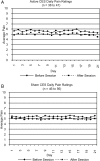Efficacy of cranial electrotherapy stimulation for neuropathic pain following spinal cord injury: a multi-site randomized controlled trial with a secondary 6-month open-label phase
- PMID: 21756567
- PMCID: PMC3127367
- DOI: 10.1179/2045772311Y.0000000008
Efficacy of cranial electrotherapy stimulation for neuropathic pain following spinal cord injury: a multi-site randomized controlled trial with a secondary 6-month open-label phase
Abstract
Background: Chronic pain is a significant problem for many individuals following spinal cord injury (SCI). Unfortunately, SCI-related neuropathic pain has proven to be largely refractory to analgesic medications and other available treatments. Cranial electrotherapy stimulation (CES) has been effective in managing some types of pain. It involves the application of a small amount of current through the head via ear clip electrodes.
Objective: Explore the effectiveness of CES for neuropathic pain in persons with SCI and chronic pain.
Study design: Multi-site, double-blind, sham-controlled study.
Participants: Adults with SCI and chronic neuropathic pain at or below the level of injury were randomized to receive active or sham CES.
Intervention: Application of active CES or sham CES 1 hour daily for 21 days. Six-month open-label phase to assess 'as-needed' CES use.
Outcome measures: Change in pre- to post-session pain ratings as well as change in pain intensity, pain interference, pain quality, pain beliefs and coping strategies, general physical and mental health status, depressive symptomatology, perceived stress, and anxiety pre- to post-treatment.
Results: The active group reported a significantly greater average decrease in pain during daily treatments than the sham group (Kruskal-Wallis chi-square = 4.70, P < 0.05). During the 21-day trial, there was a significant group × time interaction for only one outcome variable; the active group showed larger pre- to post-treatment decreases in pain interference than the sham group did (F = 8.50, P < 0.01, d = 0.59).
Conclusions: On average, CES appears to have provided a small but statistically significant improvement in pain intensity and pain interference with few troublesome side effects. Individual results varied from no pain relief to a great deal of relief.
Figures


References
-
- Tan G, Young S. Pain-related psychosocial and vocational issues in rehabilitation. In: Monga TN, Grabois M. (eds.) Pain management in rehabilitation. New York: Demos Medical Publishing; 2002. pp. 35–57
-
- Nepomuceno C, Fine PR, Richards JS, Gowens H, Stover SL, Rantanabol U, et al. Pain in patients with spinal cord injury. Arch Phys Med Rehabil 1979;60(12):605–9 - PubMed
-
- Turner JA, Cardenas DD, Warms CA, McClellan CB. Chronic pain associated with spinal cord injuries: a community survey. Arch Phys Med Rehabil 2001;82(4):501–9 - PubMed
-
- Rintala DH, Loubser PG, Castro J, Hart KA, Fuhrer MJ. Chronic pain in a community-based sample of men with spinal cord injury: prevalence, severity, and relationship with impairment, disability, handicap, and subjective well-being. Arch Phys Med Rehabil 1998;79(6):604–14 - PubMed
-
- Siddall PJ, Loeser JD. Pain following spinal cord injury. Spinal Cord 2001;39(2):63–73 - PubMed
Publication types
MeSH terms
LinkOut - more resources
Full Text Sources
Other Literature Sources
Medical
